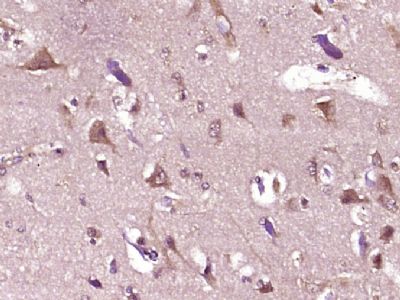UBXD2 Polyclonal Antibody
Purified Rabbit Polyclonal Antibody (Pab)
- 产品详情
- 实验流程
Application
| WB, IHC-P, IHC-F, IF, ICC, E |
|---|---|
| Primary Accession | Q92575 |
| Reactivity | Rat, Pig, Dog, Bovine |
| Host | Rabbit |
| Clonality | Polyclonal |
| Calculated MW | 56778 Da |
| Physical State | Liquid |
| Immunogen | KLH conjugated synthetic peptide derived from human UBXD2 |
| Epitope Specificity | 201-300/508 |
| Isotype | IgG |
| Purity | affinity purified by Protein A |
| Buffer | 0.01M TBS (pH7.4) with 1% BSA, 0.02% Proclin300 and 50% Glycerol. |
| SUBCELLULAR LOCATION | Endoplasmic reticulum membrane. Both the N- and the C-terminus face the cytosol; also found in the nucleus envelope contiguous to the ER. |
| SIMILARITY | Contains 1 UBX domain. |
| SUBUNIT | Directly interacts with VCP. |
| Post-translational modifications | Phosphorylated upon DNA damage, probably by ATM or ATR. |
| Important Note | This product as supplied is intended for research use only, not for use in human, therapeutic or diagnostic applications. |
| Background Descriptions | Erasin is an endoplasmic reticulum (ER) and nuclear envelope membrane protein. Expressed in a variety of tissues, such as brain, placenta, heart, liver, prostate, kidney, pancreas, lung and skeletal muscle, erasin contains one UBX domain and participates in the clearing of ERAD (endoplasmic reticulum-associated protein degradation) substrates. The UBX domain of erasin is responsible for mediating its direct interaction with VCP (valosin-containing protein), an AAA-ATPase molecular chaperone. In response to ER stress, erasin expression is induced. The knockdown of erasin expression leads to the inhibition of ERAD, suggesting an important function of erasin in the ERAD pathway. In addition, erasin may be involved in Alzheimer’s disease, as it is known to accumulate in neurofibrillary degenerating neurons in patients with Alzheimer’s disease. |
| Gene ID | 23190 |
|---|---|
| Other Names | UBX domain-containing protein 4, Erasin, UBX domain-containing protein 2, UBXN4, KIAA0242, UBXD2, UBXDC1 |
| Target/Specificity | Expressed in many tissues, including heart, brain, placenta, lung, liver, skeletal muscle, kidney and pancreas. Accumulates in Alzheimer disease-afflicted brains (at protein level). |
| Dilution | WB=1:500-2000,IHC-P=1:100-500,IHC-F=1:100-500,ICC=1:100-500,IF=1:100-500,ELISA=1:5000-10000 |
| Format | 0.01M TBS(pH7.4) with 1% BSA, 0.09% (W/V) sodium azide and 50% Glyce |
| Storage | Store at -20 °C for one year. Avoid repeated freeze/thaw cycles. When reconstituted in sterile pH 7.4 0.01M PBS or diluent of antibody the antibody is stable for at least two weeks at 2-4 °C. |
| Name | UBXN4 |
|---|---|
| Synonyms | KIAA0242, UBXD2, UBXDC1 |
| Function | Involved in endoplasmic reticulum-associated protein degradation (ERAD). Acts as a platform to recruit both UBQLN1 and VCP to the ER during ERAD (PubMed:19822669). |
| Cellular Location | Endoplasmic reticulum membrane; Peripheral membrane protein. Nucleus envelope. Note=Both the N- and the C-terminus face the cytosol. Also found in the nucleus envelope contiguous to the ER |
| Tissue Location | Expressed in many tissues, including heart, brain, placenta, lung, liver, skeletal muscle, kidney and pancreas Accumulates in Alzheimer disease-afflicted brains (at protein level) |
Research Areas
For Research Use Only. Not For Use In Diagnostic Procedures.
Application Protocols
Provided below are standard protocols that you may find useful for product applications.
终于等到您。ABCEPTA(百远生物)抗体产品。
点击下方“我要评价 ”按钮提交您的反馈信息,您的反馈和评价是我们最宝贵的财富之一,
我们将在1-3个工作日内处理您的反馈信息。
如有疑问,联系:0512-88856768 tech-china@abcepta.com.
¥ 1,500.00
Cat# AP54592























 癌症的基本特征包括细胞增殖、血管生成、迁移、凋亡逃避机制和细胞永生等。找到癌症发生过程中这些通路的关键标记物和对应的抗体用于检测至关重要。
癌症的基本特征包括细胞增殖、血管生成、迁移、凋亡逃避机制和细胞永生等。找到癌症发生过程中这些通路的关键标记物和对应的抗体用于检测至关重要。 为您推荐一个泛素化位点预测神器——泛素化分析工具,可以为您的蛋白的泛素化位点作出预测和评分。
为您推荐一个泛素化位点预测神器——泛素化分析工具,可以为您的蛋白的泛素化位点作出预测和评分。 细胞自噬受体图形绘图工具为你的蛋白的细胞受体结合位点作出预测和评分,识别结合到自噬通路中的蛋白是非常重要的,便于让我们理解自噬在正常生理、病理过程中的作用,如发育、细胞分化、神经退化性疾病、压力条件下、感染和癌症。
细胞自噬受体图形绘图工具为你的蛋白的细胞受体结合位点作出预测和评分,识别结合到自噬通路中的蛋白是非常重要的,便于让我们理解自噬在正常生理、病理过程中的作用,如发育、细胞分化、神经退化性疾病、压力条件下、感染和癌症。








